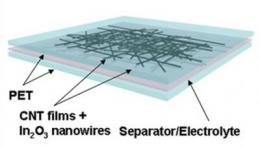 News of carbon nanotube and indium nanowire-based supercapacitors that can be bent and twisted like a playing card:
News of carbon nanotube and indium nanowire-based supercapacitors that can be bent and twisted like a playing card:
It continues a line of prototype devices created at the USC Viterbi School of Engineering that can perform the electronic operations now usually handled by silicon chips using carbon nanotubes and metal nanowires set in indium oxide films, and can potentially do so at prices competitive with those of existing technologies.
…
Its creators believe the device points the way to further applications, such as flexible power supply components in “e-paper” displays and conformable products.
This sounds like the sort of development that could lead to something like The Young Lady’s Illustrated Primer of The Diamond Age by Neal Stephenson.
[from Physorg][image from Physorg]
 With the wind firmly in the sails (lolwhut?) of hybrid cars auto giant GM is to get into the electric battery business:
With the wind firmly in the sails (lolwhut?) of hybrid cars auto giant GM is to get into the electric battery business:
The company also plans to increase its in-house battery development by building a 31,000-square-foot battery lab and hiring hundreds of battery engineers. GM is also working with a battery-engineering program at the University of Michigan to train new engineers. The lack of qualified and experienced battery engineers in the United States has been one of the big challenges facing battery startups such as A123 Systems. Most advanced battery production takes place in Asia, and this could hold back a switch from conventional vehicles to electric ones in the United States.
Technology Review have also created an interesting infographic of how a hybrid car works.
[from Technology Review][image from jaqian on flickr]

Lithium-ion batteries, such as those used in your laptop, mobile phone or hybrid car, are extremely important in today’s world but are limited by the amount of lithium ions that the typically carbon anode can hold. Stanford announced this week they’ve developed a new method that can increase the amount of charge held by as much as 10 times.
The new battery uses what is perhaps the technology of the next ten years – nanowires. At large scale, the swelling of the lithium ions when they absorb positive charge breaks the structure of the silicon holding them. The researches instead used a mesh of microscopic silicon nanowires that bend and swell under the pressure but do not break. The researcher, Yi Cui, said:
Manufacturing the nanowire batteries would require “one or two different steps, but the process can certainly be scaled up,” he added. “It’s a well understood process.”
I’ll look forward to my laptop with 25 hour battery life in a few years, then.
[via Daily Kos, image from the Stanford article, apologies for my absence this week – I’ve been wrestling with my wireless connection on Ubuntu Gutsy]
 Toshiba has reported that it plans to launch a new range of SCiB batteries in March 2008 that charge up to 90% capacity in just five minutes and have a lifetime of 5000 charges without much reduction in charge (an effective lifetime of 10 years). The two versions, 2.4V and 24V, shouldn’t explode either, which is always a bonus. Although this battery is designed primarily for the hybrid car and electric bicycle market, as Engadget and DailyTech comment this would be incredible in the laptop market…
Toshiba has reported that it plans to launch a new range of SCiB batteries in March 2008 that charge up to 90% capacity in just five minutes and have a lifetime of 5000 charges without much reduction in charge (an effective lifetime of 10 years). The two versions, 2.4V and 24V, shouldn’t explode either, which is always a bonus. Although this battery is designed primarily for the hybrid car and electric bicycle market, as Engadget and DailyTech comment this would be incredible in the laptop market…
[via Engadget, image by Toshiba via DailyTech]
Presenting the fact and fiction of tomorrow since 2001
 News of
News of  With the wind firmly in the sails (lolwhut?) of hybrid cars auto giant GM
With the wind firmly in the sails (lolwhut?) of hybrid cars auto giant GM 
